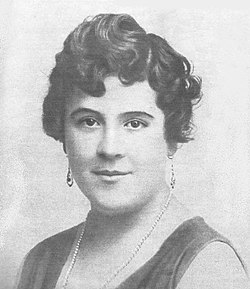Born on 9th December 1914 to Dona Aurora Rodriguez, Hildegart was a girl that was always going to be an achiever. Her mother was not married to her father, they met only once. Rather, as a believer in eugenics, Dona chose her partner carefully in order to ensure that her daughter would be both intelligent and beautiful, and chose to raise her daughter as a single parent.

Hildegart’s mother is frequently described as controlling and overbearing, but it also meant that Hildegart excelled and developed skills much earlier than the norm. When she was two years old, Hildegart could already read. When she was four, she could type. When she was ten, she spoke four languages, including German, French and English. By the time she was eleven, her interest in sexuality and feminism had consolidated and she was giving lectures on these topics. Unfortunately the location these lectures took place and to whom they were given is unknown as they took place when Hildegart was a young girl and before she really gained celebrity as a prominent feminist, socialist activist and a proponent of eugenics.
At thirteen years old, Hildegart enrolled into law school at Complutense University of Madrid, and she became a lawyer at seventeen. While there, she aligned herself with the populist socialist political ideas that were emerging in Spain, much to her mother’s dismay. After graduating, she also began to study medicine.
Hildegart was also a published author, and she published various books and pamphlets on sexual reform. This work included Sexo Y Amor, La Revolution Sexaul and Educacion Sexual, all of which were successfully circulating Madrid shortly after publication. I think it’s revealing how focused a girl as young as Hildegart was on female bodily autonomy. We can only speculate from where this interest stemmed, but no doubt it was influenced by her mother who was never one for traditional gender norms and had used sex as a way to achieve her own goals, namley providing her with Hildegart, at a time when women’s sexual independence was hotly debated and often disregarded. Hildegart’s belief that there was a sexual problem plaguing society and this problem was the unhappiness found within large families illustrates just how firmly her mother had influenced her thoughts and feelings in regards to reproduction. This led her to believe a sexual revolution was needed.
When she was sixteen, Hildegart began corresponding with prominent US sexual revolutionaries including Margaret Sanger and Havelock Ellis. Notably, Hildegart hoped to learn from Margaret Sanger about American customs and laws regarding sex reform, stating in a 1931 letter, “But the special motive of my writing to you is to beg your help for me in the work which I have enterprise, I would desire to know the laws, the propositions, the ideas and the books which are given to publicity in all countries but specifically in United States of America where you can so well know the development of people in this interesting object.” In response, Sanger wrote to Haverlock Ellis in disbelief of Hildegart’s achievements and beliefs, stating “I loved the jumps she made! Like a race horse run wild.” Sanger went on to send Hildegart literature on sex and contraceptive movements in the United States.
Additionally, Hildegart corresponded with Haverlock Ellis, who became enraptured with her. Ellis even went on to publish a book about the girl entitled “The Red Virgin,” a profile of Hildegart that is a key source of much of Hildegart’s young life. Hildegart also told Ellis of her mother’s beliefs in eugenics and that her mother had a “master plan” for her. Influenced by her penpals who she was in contact with for three years, Hildegart was inspired to organise an international conference in Madrid about birth control, contraception and sexual revolution. She was encouraged by Margaret Sanger, who hoped Hildegart would lead efforts to establish birth control centers and information networks in Spain. In response, Hildegart formed the World League for Sexual Reform’s Spanish chapter.
However, before it was able to take place in June of 1933, when Hildegart was only nineteen years old, she was sleeping when her mother shot her four times and she died. At the murder trial, Hildegart’s mother, Aurora, stated that she killed her daughter because she knew Hildegart was falling in love with a man (who remained unnamed) and believed that Hildegart planned to run away, stating “I knew she was going to run away with him, so I killed her. She was too good, too beautiful. She had a mission on this earth but it was not matrimony.”
Aurora was found guilty and sentenced to an asylum, where she died in 1955.
There is much speculation surrounding the things Hildegart might have achieved if she had not died, and the motivations as to why her mother decided to kill her prodigy she had worked so hard to cultivate. To me Hildegart’s life was one enmeshed with the changing political climate in which she lived, an overbearing mother who disagreed with her politics, and an intellect far beyond her years. Her story was tragic but it also shows how girls no matter their background and age can take an interest in and pursue passions that some may consider beyond them. Yes Hildegart was a virgin when she died, but that did not stop her from realising that women should have control over their reproductive rights, they should not be confined to child rearing and that they can be powerful political proponents if they want to be.
